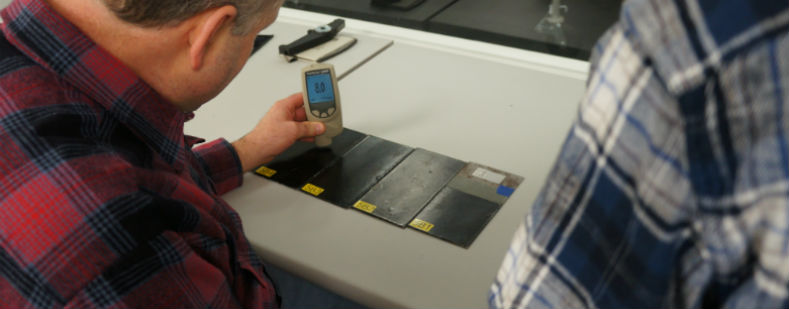If there was a college major for the coating of metal substrates, the first class would be Surface Preparation 101. The main theme would be maximizing coating adhesion…and to do this, a number of criteria would be taught including visual cleanliness, removing invisible contamination (salts/chlorides, oils, grit embedment), and how to create the coating’s required surface profile.
Accurate measurement of substrate profile is done multiple times to confirm the correct surface profile reading. This is done because a coating applied on too deep of surface profile will be too thinly applied, potentially exposing the peaks of the substrate, leaving it susceptible to premature coating failure. Alternatively, a coating applied on too shallow of a surface profile will have issues with adherence.
Measuring the profile (or anchor pattern) of a substrate can be done using a variety of tools. Testex, Elcometer, and DeFelsko are industry leaders of surface profile inspection equipment. Technologies for measuring surface profile vary. Some employ the use of digital tools, while others use analog technology paired with visual assessment.
Common surface profile testing methods include:
1. Replica Tape
Replica Tape (or replica film) consists of a crushable foam on a non-compressible tape. When the  replica tape is rubbed onto a profiled metal substrate it creates a reverse image of the surface. This manageable, compressible foam is then measured with a micrometer. The compression in the foam gives the average anchor profile measurement. The Society of Protective Coatings (SSPC) recommends taking a minimum of three replica tape samples per 10m² (100f²) to determine the average profile.
replica tape is rubbed onto a profiled metal substrate it creates a reverse image of the surface. This manageable, compressible foam is then measured with a micrometer. The compression in the foam gives the average anchor profile measurement. The Society of Protective Coatings (SSPC) recommends taking a minimum of three replica tape samples per 10m² (100f²) to determine the average profile.
Advantages: Historically proven to be accurate and simple to operate. A physical record of each test sample can be kept for record. The surface being measured doesn’t have to be completely flat.
Disadvantages: The process of using replica tape is time and labor consuming. Like most methods, replica tape requires equipment calibration and attention to reading results accurately. Different tape thicknesses are needed for different profile specifications; using the wrong tape thickness can provide false readings.
The NACE standard for using Replica Tape can be found here: NACE SP0287-2016 (formerly RP0287), “Field Measurement of Surface Profile of Abrasive Blast-Cleaned Steel Surfaces Using a Replica Tape”
2. Pin Gauge
Pin Gauge testing of an anchor profile is one of the quickest ways to test a surface. To maintain accuracy, test kits must be calibrated with a piece of glass to maintain accuracy. Usually a number of tests are done on an area and an average surface profile is calculated. ASTM D4417-14 requires 10 readings of that surface. These 10 results are then averaged. This average is what is used for the surface profile reading.
Advantages: Profile pin gauge testing equipment is frequently compact. Many models offer electronic record keeping and storage. Pin Gauges provide instantaneous results. Units are DC powered. Typically profile gauges have easy to read displays.
Disadvantages: Unit Accuracy can be affected by positioning. Rapid location transitioning can encourage variance in application technique. Recorded data can be reviewed but not re-measured. Measuring can only be done on a flat surface. Calibrations must be done before every use.
The ASTM standard for using pin or profile gauges can be found here: ASTM D4417-14 Standard Test Methods for Field Measurement of Surface Profile of Blast Cleaned Steel
3. Microscopic Surface Graphing and Analysis of a Sample
Microscopic measurements of a surface profile is done using a microscope under a high magnification, typically 30x or higher. This kind of surface analysis is mainly done by scientists in labs, sometimes after a coatings failure. This method can be done multiple times with a single sample to confirm results.
Many standards created for the analysis of a surface profile after it’s been prepared require an unaided (or unmagnified) view of the surface. This is why microscopic analysis is usually done after a coatings failure or issue.
Advantages: Microscopic review of profiled samples are accurate. Usually an analysis is complete with 3D graphical images depicting the sample’s surface.
Disadvantages: Unfortunately equipment for microscopic surface analysis of surface profiles are non-portable and can be very expensive.
4. Surface Profile Comparator
A Surface Profile Comparator is a two-part tool that uses a specialized magnifying glass, and a wheel that has been blasted to verified profiles. An inspector places the magnifying glass on the surface and under lighted magnification compares the test substrate to the verified profiles.
Advantages: Surface Profile Comparators are simple, straightforward tools. These kits are portable,  and can be taken to most job sites.
and can be taken to most job sites.
Disadvantages: Surface profile comparator tests are subjective. These tests provide low accuracy results, based on a visual assessment of the surface under magnification. Inspectors can reach different results while analyzing the same surface.
*Surface Profile Comparator Image from SSPC website found here










